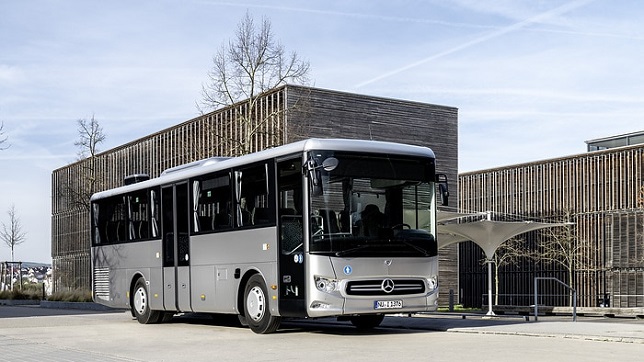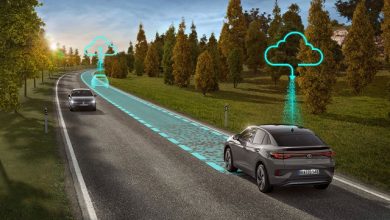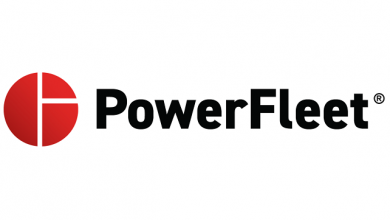A double premiere: The compact Mercedes-Benz Intouro K hybrid inter-city bus

Electromobility has many facets. While the emphasis is on all-electric drive systems for urban traffic, Daimler Buses is relying on the Mercedes-Benz Intouro with its hybrid module for inter-city transport as well as for a combination of regular-route and touring coach services in the company’s efforts to continue to decrease the already economic fuel consumption. The hybrid module is available for all two-axle models with automatic transmission featuring the torque converter from the ample Intouro range. The hybrid module is also making its debut in an inter-city bus in the equally new Intouro K. This means that the model range is simultaneously expanding by a versatile and particularly maneuverable as well as economical bus with a wide range of applications.
Hybrid technology leads to noticeable consumption advantages
Mirko Sgodda, Head of Sales, Marketing and Customer Services at Daimler Buses: “With the new Intouro K hybrid, we have brought a true all-rounder to market for our customers – not only for inter-city routes or trips out, but also for many other applications. With its hybrid technology, tangible consumption benefits can be achieved which means we are realizing an important objective: We are optimizing our already economical and low-emission combustion engine, keeping our eyes on profitability and environmental protection.”
The principle: Generating braking energy and making it usable to move off
The basic function of the Intouro hybrid is extremely simple: An additional electric motor acts as an alternator during the vehicle’s braking and overrun phases, converting braking energy into electricity. This current is stored and is available to the electric motor to support the combustion engine, especially when moving off, but also when accelerating.
The drive technology behind it is simple. One key component of the hybrid drive is the electric motor. The disc-shaped major assembly with integrated power electronics and a thickness of eight centimeters has been integrated between the combustion engine and the automatic transmission. Its output is 14 kW with a torque of 220 Nm.
The electric motor primarily assists the combustion engine in the case of high output requests, especially when moving off. However, it does not serve to increase the maximum output, which is why the specifications for the vehicle’s performance and torque remain unchanged. Rather, the electric motor supports the combustion engine and increases the moving-off performance. The combustion engine’s speed is not reduced, the peak power is only throttled imperceptibly and replaced by the electric motor.
In addition, a slight boost by the electric motor at idle speed improves the efficiency of the combustion engine. Both of these factors together result in a reduction in the already low fuel consumption. In the Intouro, this becomes particularly evident in inner city and suburban traffic where the driver is constantly alternating between the accelerator and brake pedals. The reduction is up to five percent in suburban and inner city traffic.
Supercapacitors (“supercaps”) serve as short-term energy storage units
The current generated by recuperation is stored in double-layer capacitors, also known as supercaps. These electric energy storage units are characterized by a high power density. They are not sensitive to high power peaks and have a long service life. In contrast to batteries, supercaps are ideal for the constant and rapid changes between charge and discharge when stopping and starting. The Intouro hybrid only needs a single braking maneuver from 50 km/h to a standstill to charge the energy storage units.
The power storage system of the Intouro hybrid consists of two modules. Each module contains 16 double-layer capacitors. Both modules together have a total capacity of 2 Ah and are mounted on the rear left-hand side of the roof (in the direction of travel) to save space. A cover protects the modules from external influences and sunlight. At the same time, a perforated side panel ensures the necessary cooling by the headwind.
An inverter, or power inverter, converts the stored direct current into alternating current to drive the electric motor. Both the inverter and the electric motor are water-cooled. The additional radiator for this low-temperature cooling with a maximum of 65 degrees Celsius is located beneath the vehicle radiator to save space.
48-volt network, low added weight, unmodified operation
Another key advantage: The Intouro hybrid does not need a complex high-voltage network which has its own necessary restrictions and safety requirements. The inter-city bus has a separate 48-volt network. This is classed as low-voltage technology and is safe to use. The unmodified auxiliary assemblies are driven conventionally. Further advantages of the compact and uncomplicated technical structure of the additional hybrid drive: The required installation space is small, the outline remains unchanged, as does the interior – no passenger seats are lost. The added weight of the hybrid drive is 254 kg. As a result, the total number of passenger seats is only slightly reduced and is insignificant in practice.
Drivers behind the wheel of the Intouro hybrid will not be able to tell a difference when handling the vehicle or even during operation. Even the instrument cluster is identical. Training is therefore unnecessary. Likewise, neither quick driver swaps, often common during regular bus service, nor changing between different buses pose any problem at all.
Tried and tested components, new: Recuperation module for the Intouro
The developers of the Intouro hybrid rely on tried and tested components. They are already used in the successful Citaro hybrid, for example, a model which has proven its worth in practice and has been using this technology for many years now. Elements including the supercaps as energy storage units have been derived from the Citaro. Citaro enthusiasts already know them as recuperation modules. However, extensive adaptation measures were required as a result of a new electric/electronic structure of the Intouro with different control units.
This recuperation module is now also available for the Intouro for the first time, regardless of the hybrid module. In addition to the vehicle batteries, it stores the current generated by recuperation and makes it available when moving off or on inclines. This relieves the strain on the alternator and thus on the combustion engine, reducing fuel consumption. The energy storage unit is also mounted on the right-hand side of the roof (in the direction of travel) to save space. The recuperation module is a prerequisite for the Intouro hybrid.
The new Intouro K: A real all-round talent, even on narrow streets
The new hybrid module will be celebrating its debut in the Intouro model series in the compact Intouro K. It is particularly manageable with a length of 10.75 meters and a turning radius of just 18.34 meters. This makes it ideal for trips through mountainous regions, on winding roads or for excursions with small groups.
At the same time, the Intouro K is a fully-fledged bus with all the outstanding characteristics of the Intouro family. In line with its broad scope of application, it is available in a wide range of equipment variants – the range extends from matter-of-fact, tender-compliant high-floor inter-city buses to excursion vehicles.
The range of equipment includes destination displays, a single or double-width entrance in the middle and two different lifts for passengers with reduced mobility. There is a large choice of seating and luggage storage options for the interior. The Intouro’s driver area, which has also been completely redeveloped, is ergonomically perfect and driver-oriented, typical for Mercedes-Benz buses. From its visual appearance to the controls and instrumentation including color display, the high-quality cockpit is as luxurious as a fully-fledged touring coach.
The engine output of the Intouro K is optionally 220 kW (299 hp) or 260 kW (354 hp). Bus and coach operators can even choose from four transmission variants: six-speed manual transmission, fully automated Mercedes-Benz PowerShift transmission or automatic transmission with torque converter from Voith and ZF.
The premier model: Versatile equipment, a role model in safety
The appearance and the equipment of the premier model is elegant, functional and practical all at the same time. The body and detachable parts are finished in metallic anthracite. The two-winged second door ensures a fast passenger turnaround at bus stops. The multi-functional special-purpose area on the opposite side is equipped with four folding seats. Comfortable Travel Star Eco seats with adjustable backrests, seat cushions and backrests with outer covers in Tiffy Gray, piping in May Green and Jet Black headrests made from Composition leather fiber material offer a high level of comfort even on longer journeys. Window curtains and a side wall trim in needle punch contribute to the pleasant ambiance on board, as does the gray patterned floor. At the same time, the Intouro K is also ready for regular service routes with a destination system, passenger signal system, preparation for the installation of a ticket printer and a mandrel for a cash register. Passengers can use their end devices regardless of how the bus or touring coach is used, benefiting from the MediaRouter for Internet access and streaming.
The equipment with its assistance systems is outstanding: Active Brake Assist 5 (ABA 5) emergency braking assistant is the only system of its kind in buses and touring coaches which can perform maximum full-stop braking maneuvers even with moving pedestrians, while Sideguard Assist warns of people and obstacles when turning corners. Along with conventional assistance systems, this ensures that the Intouro K can achieve exemplary safety levels.
The Mercedes-Benz OM 936 engine is just as compact as the bus itself. It delivers 260 kW (354 hp) with a displacement of 7.7 liters. It is connected to the ZF Ecolife 2 automatic transmission with torque converter and a Mercedes-Benz hypoid axle. The new hybrid module, which is available as special equipment, further reduces fuel consumption and thus emissions from this powerful and equally economic drivetrain.





